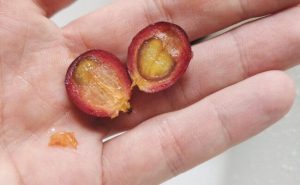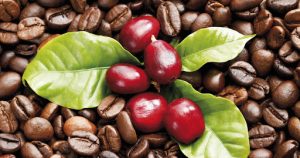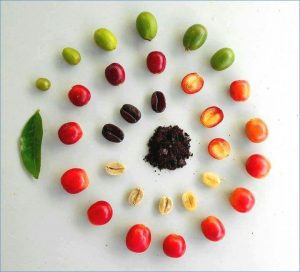
Coffee Cherries are edible and nutritious.
Coffee is a weed? Absolutely and out of control in places like Hawaii and Sri Lanka. More to our point if you ate the Coffee Cherry before you ever head or knew about the beverage you probably would have never roasted the seeds. You would have just eaten the fruit and look forward to it every year.
It sounds odd to say but sometimes you eat a food that just doesn’t seem like food. It’s not substantial or satisfying. The Coffee Cherry — the fruit the coffee “beans” come from — tastes like real food, substantial. Your pallet recognizes it immediately and says “this we will eat again.”

The unripe seeds called green coffee beans are roasted for coffee.
Actually the fruit can be divided into three parts: The outer skin, the pulp and the seeds (usually two seeds but not always.) The pulp is sweet and contains a small amount of caffein. The skin can be plain or a little bitter though I have not tasted one like that. It actually reminds me of a Cocoplum. Some people don’t like that fruit from a texture point of view. The Coffee Cherry fruit is slightly tough on the outside and a bit slimy on the inside. The pulp can also be dried and made into a “flour” that is used more like a seasoning than a flour. As millions of pounds of it are thrown away every year they are trying to find ways to use it. It’s full of polyphenols most of which is chlorogenic acids, ten times greater than what you get from the beverage
The Coffee Cherry itself has 144.9 calories for 100 grams. That delivers 51 grams of fiber, 425 mg of calcium, 333 mg of magnesium, 49.6 mg of iron, 15.7 mg of sodium, 530 mg of caffeine and 22 mmol of antioxidants. We see them in my foraging classes in Orlando and West Palm Beach.

Coffee Cherries: Good food or pulp fiction?
Not only can you grow your coffee you can grow decaf. One strain of C. arabica naturally has very little caffein. The usual C. arabica has 12 mg of caffeine per gram of dry mass this strain has 0.76 mg per gram but the same flavor. Coffee was originally grouped with Jasmines because of the flower’s aroma. And you can make a tea out of the leaves which also has some caffeine. The plant is native to a strip across the widest part of Africa. The drink has been made for perhaps 600 years.
The genus Coffea is new Dead Latin for Coffee. The word “Coffee” came from the Dutch ‘koffie” which came from the Ottoman Turk’s “kahve” which came from the Arabic “qahwah” which referred to a type of wine really meaning a beverage that could make you less hungry and or give you energy. Arabica is from the Greek Arabikos meaning Arab or Arabian. Canephora is from the Greek Kanephoros which means basket carrying. The Caryatids — maidens — carried a basket on their heads holding sacred objects for feasts and the like.
Green Deane’s Itemized Plant Profile
 IDENTIFICATION: A shrub or small tree to 30-some feet. Open branches, well-spaced. Leaves are opposite, simple elliptic-ovate to oblong, four inches long, long, glossy, dark green. The flowers white, in axillary clusters. The seeds are a round drupe like an olive but with two seeds, ripens to bright red or purple.
IDENTIFICATION: A shrub or small tree to 30-some feet. Open branches, well-spaced. Leaves are opposite, simple elliptic-ovate to oblong, four inches long, long, glossy, dark green. The flowers white, in axillary clusters. The seeds are a round drupe like an olive but with two seeds, ripens to bright red or purple.
TIME OF YEAR: In some areas year round, in other seasonal often in winter. Locally in the fall. Do you live where it doesn’t freeze and you want a shrub that you can plant in the shade? C. arabica is a good candidate.
ENVIRONMENT: Likes it cool and elevation but many coffee plantations are in warm areas and at sea level.
METHOD OF PREPARATION: Fruit out of hand or prepared in various ways or dehydrated. Tea from the leaves.

